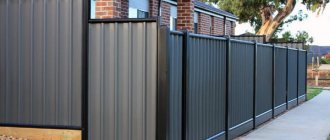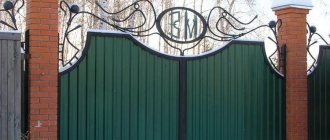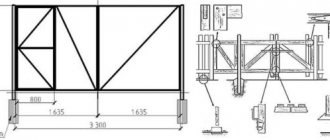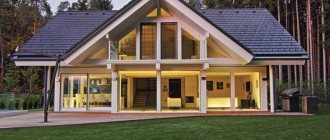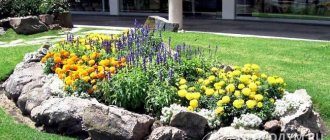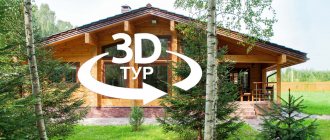- 19.08.2018
- Photo
A private house without a fence becomes more like a public place. And with a beautiful, high-quality fencing, being in the house and surrounding area becomes comfortable and safe. Your home becomes your fortress. If you are planning to order the construction of a fence in the near future, then look at the photographs of possible options for fences and fencing for a private home. We have collected a large collection of photos of all types of fencing structures so that you can choose the one that suits you in all respects: safety, appearance, price.
Universal zoning
Not only does the fence protect and decorate the area, but the thematic design also zones the area. Moreover, it is not necessary to use the same type of fence everywhere:
- For residential properties - a high or one and a half meter fence made of corrugated board, concrete, brick, stone;
- Flower beds and flower beds - a low plank or stone counterpart;
- Garden and vegetable garden - as in the case of a flower garden, but already a meter high;
- The recreation area is a board or mesh fence with climbing plants.
In the latter case, the mesh must be safe - made of rope or fiber. If the recreation area is a children's playground, then it is better to install a meter-long wooden fence with rounded ends. But real estate for farming welcomes chain-link mesh and its stainless steel analogues.
Frame materials
Timber and metal profiles are often used.
timber
Used as posts, transverse joists for fences made of boards, picket fences, polycarbonate. Pre-treated with antiseptics. The elements are connected to each other with nails or self-tapping screws.
It is possible to combine metal poles with logs made of timber. Suitable for covering sections made of corrugated sheets or Euro picket fences.
For a fence height of up to 1.5 m, two transverse joists are enough; up to 2 m, the number increases to three.
Rolled metal
Used in combination with supports made of profile pipes. For lags, pipes of smaller diameter are taken. The parts are connected to each other by welding or bolts.
Places of welding seams and joints are cleaned and treated with anti-corrosion primer.
A frame made of metal profiles is used for fences made of metal siding, corrugated sheets, welded and forged gratings.
Fence design
At first glance, the fence seems like a simple fence. But when its construction begins, it becomes clear that the thematic object consists of the following elements:
- The substrate for mounting the load-bearing base is a drainage pad or foundation;
- Load-bearing base - pillars laid out of brick-stone or ready-made logs, bars, channels, corners, fittings;
- Longitudinal fasteners for connecting load-bearing elements with their subsequent finishing;
- Finishing sheets - corrugated sheets, block house, sandwich panels;
- A gate is a movable (sliding or folding) element for moving between private property and the outside world.
If the gate is present in the fence design in a single copy, then its width is 1 m. But some people like to arrange two entrances and exits. An appropriate approach welcomes 0.8m wide gates.
Varieties
Buyers can purchase 4 types of siding:
- wood;
- vinyl;
- cement;
- metal.
Metal siding fence
Wood panels are made from pressed fiber. To improve performance characteristics, various impregnations are used. They help improve product durability and moisture resistance. Resin impregnation makes the tree uninteresting to pests and protects it from fungus.
Imitation log
Vinyl siding is made from PVC cellular structure. It differs from other types in its increased resistance to ultraviolet rays and fire. Vinyl panels under the timber are durable, last a long time, and are easy to install. Minimal maintenance is required for building materials.
Metal construction
Cement-fiber panels are made from a solution with the addition of cellulose fibers. After heat treatment, the material becomes stronger and more durable. Initially, the siding is gray and has a primed base, but the buyer can change its color to any other. Cement-fiber panels for fences are rarely used due to the complexity of installation.
Representatives containing cement
Metal siding is made from steel sheets, treating the surface with zinc or aluminum to improve properties. The high price is due to the complexity of manufacturing. The material has low mechanical strength.
Physical impact causes dents that are difficult to straighten out.
Metal siding "under a log"
A fence made of metal siding under the timber is covered with a protective vinyl layer. The coating allows you to imitate almost all tree species. The material is not flammable, it also does not fade under ultraviolet rays, tolerates temperature changes well, and is not susceptible to corrosion. The length of the panels reaches 6 m, their width is 35 cm.
Model for eurobeam
Wicket design
A simple-looking sliding structure, in addition to hinged hinges and a locking mechanism, can have:
- Visor;
- Call;
- Lamps;
- By mailbox;
- With an eye.
It is better to make the peephole wireless so that you can see guests from a distance through the video screen. But the corresponding know-how, including a visor, a bell and a letterbox, are relevant in gates made of solid boards or a universal profile.
Care
You can wash wood siding with water using soft brushes. Detergents should be gentle and not contain aggressive components. Even the simplest detergent should not remain on the surface of decorative panels for more than 10 minutes.
Additional elements
The water stream is directed from bottom to top, and not vice versa. Wood siding must be carefully protected from solvents. Scratches and chips should be painted over with paint that matches the tone. You can pre-prime the area.
If a significant area is damaged, it is better to replace it with a new one, carefully choosing the shade.
The installation of the fence is shown in the video below.
Types of wooden fence
Wood is easy to machine. However, there is no need to resort to this measure, because For the fence you can purchase ready-made:
- Vertical boards;
- Logs;
- Narrow dies.
If boards and logs are suitable for erecting a picket fence, then narrow dies are inherent in a picket fence. The latter often combines dies, concrete, and stone.
At worst, you can use available flexible branches to weave from them the so-called. wattle fence Such a fence between private houses is never used. However, it is economical and requires only a few large load-bearing supports to install the gate.
Pallets can be used. These prefabricated structures are quickly laid and secured to create fencing. And if inside the site there is a gazebo or a bench made of pallets, then the corresponding fence is doubly appropriate.
Before deepening wooden posts into the ground, their ends must be treated with an antiseptic. The diameter of the recesses should be 2 times wider than the diameter of the pillars so that the latter can be fixed with drainage. The latter also curbs the impact of groundwater.
The use of both moisture-resistant and durable species - cedar, fir, larch - deserves special attention. They prevent rotting. For the above-ground part of the fence, you can limit yourself to hardwood.
Tools and materials for work
Before starting construction work, it is necessary to prepare a drawing of the future structure, calculate the amount of consumables: cement, gravel, sand for pouring the foundation, mesh, brick (depending on the selected type of fence).
Note!
DIY branch chopper: how to make it from A to Z. 175 photos and step-by-step instructions- DIY garden paths - varieties of materials. Step-by-step instructions for DIY installation and decoration
- Do-it-yourself sauna stove: types of structures and manufacturing materials, technology and stages of work + do-it-yourself construction instructions
Also during the work you may need the following tools:
- Grinder for cutting metal and profiles.
- Welding for attaching hooks to support posts.
- Wire cutters.
- Fasteners for mounting sections.
- Containers for mixing cement mortar or concrete mixer.
- Trowels.
- Building level.
- Compositions for wood treatment (antipyretic, antiseptic, moisture-resistant and antifungal solutions).
- Decoration materials (paint, acrylic varnish).
- Anti-corrosion coating is required for metal surfaces.
Additionally, a plane and sandpaper can be useful for processing wooden parts yourself.
Corrugated fence
Unlike wooden fencing, the analogue made from corrugated sheets does not rot or ignite. On the other hand, corrugated sheeting is just a finishing, which is noticeable in the photo of fences for the house.
Moreover, the finishing is attached to the load-bearing part, which can be presented in the form of pillars made of brick, stone and even timber. Moreover, the latter is worse suited for profiled flooring than other building materials, because it, again, is subject to rotting and ignition.
As for the corrugated sheeting itself, it stands out for the following features:
- Quickly attaches due to the large area of its sheets;
- Fills the fence completely due to the integrity of the structure;
- Suitable for fastening with self-tapping screws;
- Exerts a relatively low load on load-bearing pillars, foundations and fastening elements.
The main thing is that the corrugated sheeting is attached longitudinally in two rows - bottom and top. This approach maximally fixes the thematic building material in one plane and at the same time prevents shifts during strong winds.
What materials are the pillars made of?
Let's look at the types of raw materials that are in greatest demand.
Log
Selected for fencing made of boards, picket fences, timber, and various types of sections. They require mandatory protective treatment.
How to choose good raw materials, install wooden poles.
Brick
The pillars are distinguished by their reliability and, at the same time, labor-intensive masonry. They are built around professional pipes.
They are used when laying both solid brick fences and sections of corrugated board, forged gratings, and metal siding.
Metal pipes
They are considered the most popular option for supports for fence structures. Pairs perfectly with any sectional material.
During installation, you will need skills in working with a welding machine.
Related articles:
- How to Install Metal Fence Posts
- Wooden fence on metal posts
Asbestos cement pipes
Not so popular material. In the private sector, it is used if asbestos-cement pipes remain from the dismantling of old structures.
To fasten the sections you will have to use mortgages. The top of the pipe must be covered with a special lid or cap. Otherwise, water that gets inside will freeze in winter, which will lead to expansion of the material and the formation of cracks. Under strong mechanical loads, the pipes may crack.
Brick fence
A heavy-duty fence is usually called a fence that is entirely made of brick, stone or cement. How to build a fence at home if it puts a large load on the foundation? Everything is simple - the foundation should be strip - in the form of a continuous strip of reinforcement, filled with cement mortar. To prevent the latter from mixing with the soil in a liquid state, the trench for the reinforcement is preliminarily finished with plank formwork.
Before organizing the formwork, the bottom of the trench is covered with a drainage layer of sand and crushed stone. The height of the layer is 4-6 cm. The depth of the entire strip foundation for a heavy-duty fence is 0.3-0.5 m (the greater the load on the foundation, the deeper the foundation should be).
As for the above-ground part, it is arranged sequentially - from each bottom row to the top. Although it is more profitable to install a concrete fence from ready-made cement sheets or blocks than to pour it on site using a pre-built reinforcement frame.
Brick fences for a private house are welcomed by ordinary brick M150, stone fences - limestone, dolomite, granite, pebbles. It is more convenient and safer to place stones inside the reinforcement frame than to stack them on top of each other.
A heavy-duty fence can be not only solid, but also combined - with the presence of forged products. The site can be easily seen through such a fence, but the structure itself looks very original.
Regardless of the integrity of a heavy-duty fence, its posts must be topped with hipped (hatched) canopies.
TOP 9 materials for enclosing structures
To build fences around your home area, you can choose wood, brick, natural or artificial stone, metal and concrete structures. Combinations of several materials also look organic.
There are a lot of materials that can be used
Tree
Wooden structures are a traditional type of fence for private households, which have protected estates since ancient times. Their popularity is due to the availability and low cost of the material, as well as the variety of options. You can use coniferous or deciduous wood as raw materials.
Wood is a great choice
Examples of wooden fences
1 Pletni. To make it, you will need willow twigs or other plants, which are cleaned or left in their original form. Such fences are usually used to divide an area into zones, since they do not provide reliable protection and require constant updating. The fences look harmonious with wooden houses in a rustic style.
Wattle using boards
2 Picket fences. You can build it from wooden planks, which need to be fixed on horizontal crossbars. A gap of different sizes is left between adjacent elements, and their tops can have different shapes.
The gap in the picket fence is at your discretion
3 Fence made of logs or timber. They can be positioned horizontally or vertically. The diameter of the logs is selected in accordance with the massiveness of the house, which must also be built of wood.
Timber fence
Unlimited scope for imagination is provided by a fence made of boards. Depending on your wishes, it can be solid or imitate weaving.
Lattices, assembled with large gaps between the boards, are used in the form of sections for fencing. They can also serve as a basis for climbing flowers or plants planted around the perimeter of the site.
Imitation of weaving from boards
If you want to preserve the natural texture of wood, avoid using paints and varnishes that form a dense layer after application. In this case, impregnation or a special varnish for outdoor structures is better suited.
Classic combination of wood and stone
Brick and stone
More durable materials that you can use to build fences are brick and natural stone. They allow you to build reliable and durable structures, but require a foundation. Basalt, granite or porphyry are used for fences.
Durable granite fencing
The luxury of stone allows you to avoid complex structures by constructing fences of simple shapes. Their beauty is enhanced by bright flowers and evergreens. Cracks, chips and other defects create the effect of aged structures, which are ideal for buildings with similar facade designs.
Luxurious stone fence
To save money, you can replace natural material with artificial stone or small cobblestones. An interesting option for fencing are structures made of posts and mesh filled with pebbles or gravel. Such fences resemble gabions and harmoniously combine with the deliberately rough texture of the pillars and facades of the house.
Common types of pebbles
Brick fencing is the best option for owners of cottages lined with the same material. Such fences will reliably protect your territory from prying and prying eyes. To avoid monolithic and ordinary perception, brick structures are decorated with turrets, arches and other decorative elements.
For lovers of intricate stone and brick fences
Fences that are constructed using a checkerboard pattern look interesting. In addition, this method allows you to save material and reduce the cost of constructing a fence.
Concrete structures
As an alternative to massive structures made of brick or stone, you can use ready-made concrete structures. They are sections of different sizes and shapes that are fixed in the grooves of the pillars. The front surface of concrete panels can have different textures: smooth or rough, glossy or matte.
Ready-made concrete structure
You can buy both tinted and unpainted sections and choose the appropriate shade taking into account the architectural and color schemes of the house.
Another option for concrete fencing is block construction. You can choose a material with the texture of natural stone, wood, or with a fancy surface pattern. Supplemented with posts, caps and other decorative elements, a concrete fence will decorate a dacha or city house.
Concrete block structures are reliable and strong
If you want your concrete fence to be indistinguishable from wooden structures, carefully select paint compositions and avoid bright, saturated colors.
Metal
Metal fences are strong and durable structures. Thanks to painting with special compounds, they are resistant to corrosion and do not deteriorate over time under the influence of moisture. The variety of metal shapes allows you to create simple and complex designs.
A modern metal fence always looks trendy
From profile pipes
The simplest option is a fence, the sections of which are made of profile pipes secured to each other by welding. You can choose an option with a different combination of metal pieces formed into a single pattern. Such structures look especially impressive next to a house whose cladding is made of brick or stone.
Profile pipes that are attached to each other
Fences made from profile pipes do not provide complete privacy due to the many gaps between the elements. To protect from prying eyes, metal sections can be combined with profile sheets or boards. Privacy can also be achieved using polycarbonate of different colors and shades.
We supplement the design with polycarbonate
From a picket fence
No less popular due to their availability and ease of maintenance are fencing made of profiled metal sheets or picket fences. Structural elements are painted at high temperatures under pressure, so they retain their brightness and color saturation for a long time. The decorative layer also performs protective functions: thanks to the paint coating, your fence will be resistant to moisture and will not require replacement for a long time.
Stable and painted picket fence
Profiled sheets
For fencing construction, you can purchase profiled sheets, the front surface of which imitates materials of different textures. Sections with the texture of stone or wood of walnut, oak, cherry and other species are available for sale. Thanks to this finishing, the fence around your house will be unusual in decor and durable, since metal has a long service life.
Profile sheets for fence
A metal picket fence is made from profiled sheets in the form of lamellas of a certain width. The planks are fixed with a small gap on horizontal crossbars parallel to each other. They can be placed both vertically and horizontally.
Option for vertical arrangement of corrugated sheets
Metal sheets
An interesting type of fencing is represented by metal sheets with carved patterns or perforations. They are fixed to poles and create the effect of an openwork and weightless structure.
To make a fence made of profiled sheets or a metal picket fence look like a single monolithic structure, use posts, crossbars and fastening elements whose color matches the color of the base material.
We combine colors in one design
An elite version of metal fencing is forged structures, which are characterized by high cost and spectacular appearance. The more complex the pattern, the more expensive each section of the fence will cost you. If you want to save money, you can use welded structures made from profile pipes, complemented by forged inserts and patterns.
Corrugated sheeting with forged inserts and patterns
Decorating the fence
A beautiful fence for a home is a fence that stands out:
- A design that is similar to the decoration of private real estate;
- Limited color options.
Such a fence itself is laconic, which means it can not only be used for its intended purpose, but also serve as a backdrop for climbing bushes or small flowers.
In rare cases, the fence can be supplemented with improvised accessories. For example, the mesh is suitable for cutting multi-colored bottle caps into the cells. Moreover, they must be embedded in such a way that the output is a drawing. True, the lids will have to be glued with epoxy glue so that they do not come off.
Advantages
A siding fence has many advantages:
- It will last more than 50 years, without losing its properties over the years, without fading.
- Doesn't require much effort to keep clean.
- Corrosion does not damage the structure due to special surface treatment.
- Cost-effective – a fence made of siding will cost less than a brick structure.
- A wide selection of shades allows you to create unique fences by combining different panels.
- The high strength of the material allows the fence to withstand good wind loads.
- Resistance to climate change makes the timber material universal, making it possible to use it in all regions.
- The ease of installation allows a person working with the material for the first time to make a fence themselves.
- The light weight of the panels reduces the requirements for the foundation, simplifying installation.
Types of models
Photos of the best fence options for your home
Price
The price of metal siding varies quite widely. Economy class wood-look panels can be purchased for 160–220 rubles apiece, while standard ones will cost 230–290 rubles. Premium material with improved performance characteristics is sold for 300–520 rubles per panel.
Color harmony
Making a fence from siding is quite easy by following the instructions. A correctly installed foundation and the evenness of the sheathing affect the appearance of the future structure. By regularly caring for your fence, you can significantly extend its lifespan. The duration of operation depends on the quality of wood or log panels.

